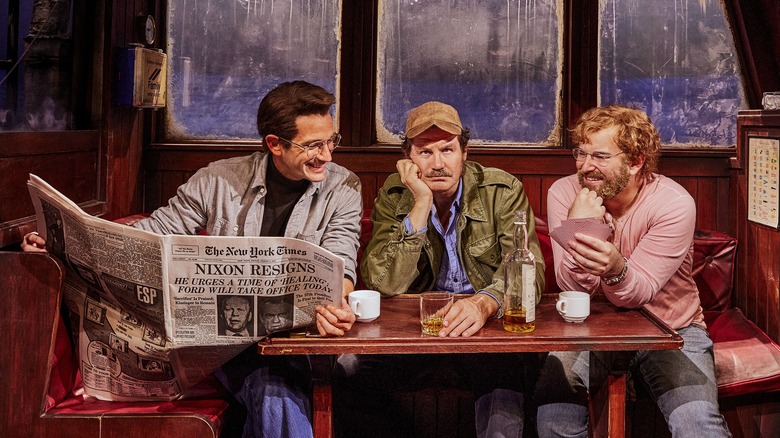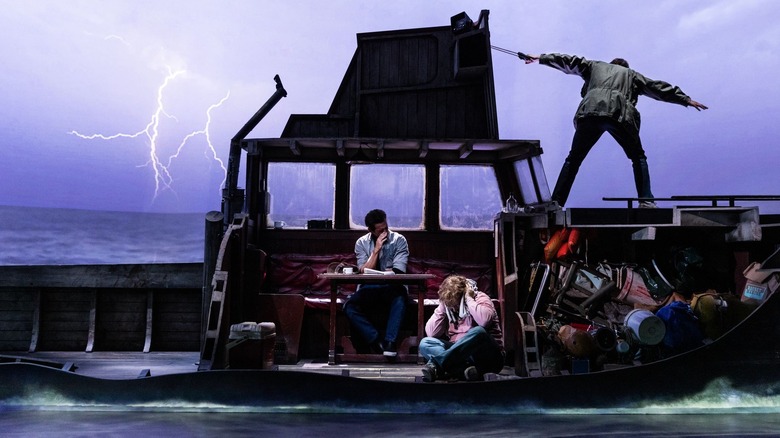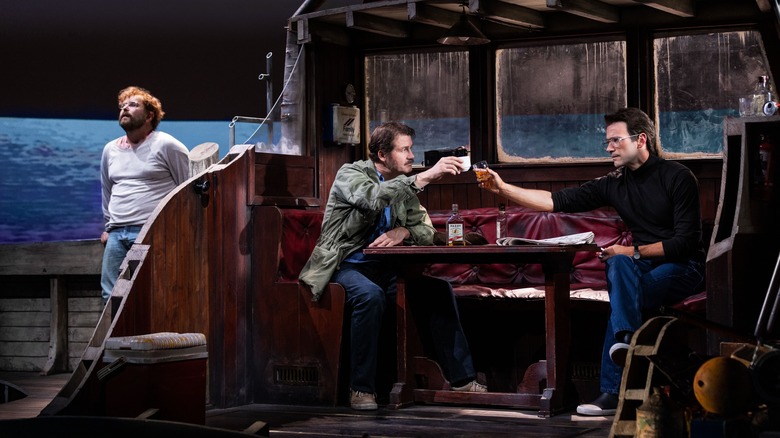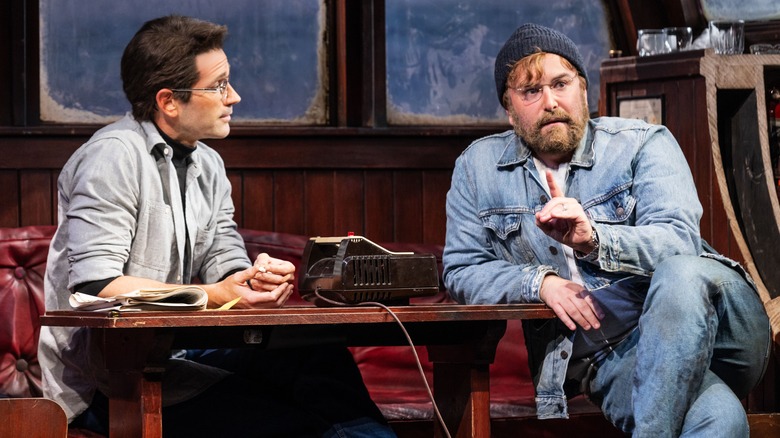The Shark Is Broken Review: The Disastrous Making Of Jaws Is Now A Broadway Play
"You always think, if you're a proud son, that you could talk to your father and you could help ... Well, I never got to that." Playing his late father onstage, Ian Shaw delivers these devastating words in "The Shark Is Broken" with matter-of-fact gruffness. His face also bears the weathered and mustached likeness of his father, the late Robert Shaw, the man who embodied the sea captain, Quint, in the 1975 watershed "Jaws."
The legends of the behind-the-scenes snafus of "Jaws" (adapted from Peter Benchley's novel) wouldn't be complete without Robert Shaw's on-set drunkenness, his documented feud with co-star Richard Dreyfuss, and a scuffle provoked by Dreyfuss tossing his alcohol into the sea (loosely dramatized in this play). With co-writer Joseph Nixon, the younger Shaw took inspiration from his father's drinking diary, family archives, and other "Jaws" sources to pen "The Shark is Broken," a comic meditation on the blockbuster's legacy and the three leads who made that legacy possible. The show premiered in Brighton, England shortly before its 2019 Edinburgh Festival Fringe run. After running on the West End, "The Shark is Broken" has made its splash onto the Broadway stage under Guy Masterson's direction. A "Jaws" aficionado will appreciate this one.
On the ocean east of Martha's Vineyard in 1974, a filmmaking team is shooting a film called "Jaws." The production setbacks can't be understated: over budget and over schedule, a screenplay revised on-the-fly, brewing skepticism against the newcomer director Steven Spielberg, and a malfunctioning mechanical 25-footer shark. Across the never-ending weeks aboard the Orca (the setpiece that serves as Quint's fishing boat) in between the shark's repair, the three lead actors kill time together, chat about their stage and screen careers, and push each others' buttons. Throughout this three-hander, Ian Shaw's Broadway co-stars occupy the Orca with convincing camaraderie. Alex Brightman exudes some of his "Beetlejuice The Musical" energy to Dreyfuss, who played the cocky oceanographer Matt Hooper, while an amiable Colin Donnell is the lanky Roy Scheider, who portrayed the police chief Martin Brody.
A father-son story
In the "Jaws: The Inside Story" documentary, the real Dreyfuss once described Shaw, a veteran actor, as a privately kind and gentle person, then "on the way to the set, he was possessed by some evil troll who would then make me his victim." Just as the rugged working-class Quint mocks city-boy Hooper in Spielberg's picture, the onstage Shaw berates Brightman's petulant and chatty Dreyfuss to buck up and "mind your mannerisms!" Shaw's austerity exasperates Dreyfuss. Yet, being the 27-year-old relative newcomer among his fortysomething co-stars, he also longs to be Shaw.
Not unlike many of Spielberg's projects, the father-son story in "The Shark Is Broken" froths beneath the metatextual undercurrents. Heads will perk up when the onstage Robert Shaw commiserates on his father's suicide. There, we cannot unsee Ian (who lost his father at age nine and now outlived both his father's and paternal grandfather's ages) ruminating on the paternal trauma seeping into his own father's vices. Ian Shaw's dramatization plays up a dimension to Shaw Sr.'s mercurial dynamic with Dreyfuss: He can't help but parent him in his own harsh language.
You have Scheider too, a more down-to-earth Dad figure, who pops open the New York Times paper, digests the Richard Nixon-related headlines aloud, and keeps the peace between his co-stars. The play suggests that his easygoing personality was a way for him not to repeat his own father's violence, while a comic scene of him trying to sunbathe implies he's not incapable of losing his temper. Dreyfuss also shares that his father walked out on his family on his 21st birthday, culminating in a breakdown. With quality work, Shaw, Donnell, and Brightman insinuate that these men's dispositions, their varying expressions of masculinity, and their vulnerabilities were shaped by their respective milieu, especially how they observed their fathers.
Winks to the future
"The Shark Is Broken" has its biggest bite when chomping into the father-son psyche, especially for an audience already aware of Ian Shaw's relationship to the material. But Masterson's direction has trouble patching up the show's episodic structure, so the play's penultimate cool-down scene feels unearned. In addition, the script might dip into future references that test the play's believability. For example, Robert unwittingly foreshadows "Jurassic Park" in a snarky like "Whatever next? Dinosaurs?" But to the show's credit, these winks aren't just fan-service nods. They serve a purpose for how these men might contemplate their place in the film industry's future. "One day there will only be sequels. Sequels and remakes, and sequels to remakes and remakes of sequels," Robert grouses.
Through these fictionalizations of the real men, the play dispenses some observations about the men's (or anyone's) relationship to artmaking. Actors might not resonate with their given material, might even begrudge it, but that doesn't necessarily stop them from taking the work seriously on their own terms. Possessing a different math to their comprehension, each actor carries their own interpretation of the "Jaws" screenplay. Richard interprets the film as a dive into primal fears. Roy devises that the story tackles unchecked greed and responsibility. But for Robert? "It's about a shark! ... Don't read any more into it." And yet, he also detects gold in the "stinky writing" of the five-page Indianapolis speech that ends up re-drafting. When Ian Shaw performs the finalized Indianapolis speech verbatim, it's a triumph not so much for the precision but the personal context shaping its process.
A crowdpleaser for Jaws fans
With production accuracy, Duncan Henderson (who played Scheider in the show's Edinburgh run) crafted an Orca grounded in rusty realism, enclosing its trio within its tight quarters. Henderson's additional costume work tailors its fidelity to the actors' wardrobe, along with Campbell Young Associates' wig work. To a conservative effect, Adam Cork's sound design of waves, seagulls, and production voiceovers are minimal, and Nina Dunn's video design of a quasi-photorealistic sea backdrop services the scenery and few stimulated boat tilts.
A "Jaws" fan will appreciate it. It might be disappointing that "The Shark is Broken" is a good, not great, play. Through the multitudes of its thoughts, you'll wonder if Shaw and Nixon considered that this 95-minute, intermission-free play could afford to be more sprawling. Despite these kinks, each episode isn't wasted time with these men.
"The Shark is Broken" is playing at the John Golden Theatre on Broadway. The show is scheduled to run through November 19th.



